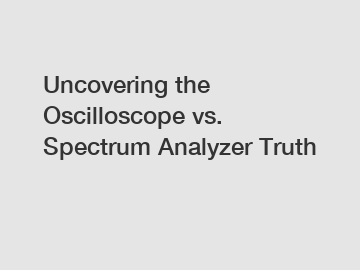Feb. 23, 2024
Measurement & Analysis Instruments
You will get efficient and thoughtful service from SUIN.
Uncovering the Oscilloscope vs. Spectrum Analyzer Truth.
In the world of electronics and signal analysis, two essential tools stand out: the oscilloscope and the spectrum analyzer. Both serve different purposes and have unique features that make them valuable in various applications. However, there is often confusion about which tool to use for specific scenarios. In this article, we will uncover the truth about the oscilloscope vs. spectrum analyzer debate to help you choose the right tool for your needs.

Oscilloscope: Understanding Waveforms.
An oscilloscope is a versatile tool that measures and displays voltage signals as waveforms. It is perfect for analyzing time-domain signals, such as voltage fluctuations and signal integrity issues. Oscilloscopes provide a detailed view of the signal's amplitude, frequency, and phase relationships over time. This makes them ideal for debugging circuits, identifying noise and distortion, and troubleshooting electronic systems.
One of the key features of an oscilloscope is its ability to capture transient events, such as glitches, spikes, and ringing, in real-time. This can be crucial for detecting intermittent faults or identifying anomalies in the signal. Oscilloscopes also offer advanced triggering options, allowing users to capture specific events or patterns of interest.
Spectrum Analyzer: Analyzing Frequency Components.
On the other hand, a spectrum analyzer is designed to analyze the frequency domain of a signal. Instead of displaying waveforms, it shows the amplitude of different frequency components that make up the signal. Spectrum analyzers are useful for identifying the frequency content of signals, detecting harmonics and spurious signals, and measuring signal-to-noise ratios.
Suggested reading:Spectrum analyzers come in different types, such as swept-tuned, real-time, and FFT (Fast Fourier Transform) analyzers. Each type has its advantages, depending on the application requirements. With a spectrum analyzer, you can perform various measurements, such as frequency response analysis, distortion analysis, and interference detection.
Choosing the Right Tool for the Job.
When deciding between an oscilloscope and a spectrum analyzer, consider the nature of the signals you are working with and the type of analysis you need to perform. If you are dealing with time-varying signals and need to visualize signal integrity, an oscilloscope is the way to go. On the other hand, if you need to analyze the frequency content of signals, detect interference, or measure spectral purity, a spectrum analyzer is more suitable.
In some cases, you may need to use both tools in combination to get a complete picture of the signal behavior. Oscilloscopes and spectrum analyzers complement each other's capabilities and can provide valuable insights when used together. For example, you can use an oscilloscope to capture a transient event and then analyze its frequency content using a spectrum analyzer.
Conclusion.
In conclusion, the choice between an oscilloscope and a spectrum analyzer depends on your specific requirements and the type of signals you are working with. Both tools have their strengths and weaknesses, and understanding their differences is crucial for selecting the right tool for the job. Whether you need to analyze waveforms in the time domain or frequency components in the frequency domain, there is a tool that fits your needs.
If you need further assistance in choosing the right tool for your application, feel free to contact us. Our team of experts can help you find the best solution for your signal analysis needs.
Click here to get more.
The company is the world’s best difference frequency generator supplier. We are your one-stop shop for all needs. Our staff are highly-specialized and will help you find the product you need.
Suggested reading:If you are interested in sending in a Guest Blogger Submission,welcome to write for us!
All Comments ( 0 )